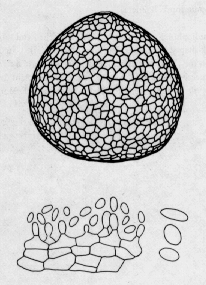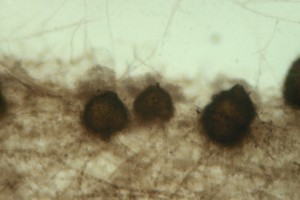Main page <> Index of descriptions <> Previous description <> Phoma <> Next description


Phoma
Recognized by its cellular and more or less round fruiting structures (pycnidia) containing masses of 1-celled colourless to yellow or pink spores (conidia). The conidia are borne from inconspicuous peg-like phialides lining the inner wall of the pycnidium. Species of Phoma having spines or setae on their pycnidia are sometimes confused with those of Pyrenochaeta. However, the two genera can be distinguished on the basis of their conidium-bearing structures: conidia of Phoma species are produced from simple phialides while those of Pyrenochaeta arise from phialides ocurring along the sides of elongated conidiophores.
Phoma is a taxonomically difficult genus and is still under study. Species identification is often difficult. Much of our present knowledge has come from the work of Dr. G.H. Boerema and his colleagues in The Netherlands. Boerema (in Aa, et al., 1990) divided Phoma into five sections, extended in 2004 (Boerema et al., 2004) to nine in a comprehensive identification manual.
Aveskamp et al., (2010) have studied the genetic relationships of fungi referrable to Phoma and have found, as Boerema himself suspected, that the genus is highly polyphyletic; that is, its species belong to a number of distinct families within the Pleosporales., including the Cucurbitaceae, Didymellaceae, Leptosphaeriaceae, Phaeosphaeriaceae, Pleosporaceae, and Sporormiaceae. While these authors agree that Boerema's classification is useful for practical identification the sections do not really reflect natural relationships.
Species of Phoma are frequently encountered in indoor environments. In fact, in an intensive study of the dust in 369 homes in western Ontario, Dr. James Scott found the species Phoma herbarum to be in nearly 30% of the homes and to be the 14th most common mould overall (Scott, 2001). This study is available online at Dr. Scott's Sporometrics website. Phoma herbarum is the type species of the genus Phoma, meaning that it is the species upon which the genus is based. It is therefore undisputedly a 'good' species of Phoma. Beside being found in indoor environments species of Phoma are common in soils, dung, and both living and dead plants.
Classification: In the true genetic sense, based on its type species P. herbarum, Phoma belongs in the Didymellaceae (Pleosporales). In a broader and less evolutionary sense it can be located in all of the families listed above. Holomorphs: many genera of ascomycetes, for example, Didymella and Leptosphaeria. Ref: Aa et al, 1990; Aveskamp et al., 2010; Boerema, 1993; Boerema et al., 1994; Boerema et al., 2004; Boerema and Dorenbosch 1973; Dorenbosch 1970; Gruyter and Noordeloos, 1992.